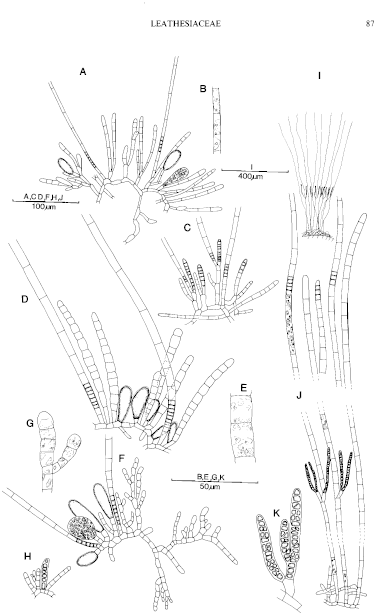|
|
|
|
|
|||||||||||
|
Electronic Flora of South Australia Genus Fact Sheet
Phylum Phaeophyta – Order Chordariales – Family Leathesiaceae
Thallus minute (less than 2 mm long), epiphytic, with a prostrate base of branched filaments, becoming entangled, producing erect, simple or branched, colourless medullary filaments continuing as simple, straight, determinate cortical filaments, with plurilocular sporangia produced laterally from upper medullary cells. Phaeophycean hairs produced as continuations of many cortical filaments by subdivision of their subapical cell to form a meristem. Cells with several phaeoplasts, each with a pyrenoid.
Thallus (Fig. 24I) medium brown, 1–2 mm high, tufted, epiphytic on Amphibolis antarctica. Basal layer (Fig. 24I,J) of branched, prostrate filaments producing irregularly rhizoidal filaments in the lower medulla, from which erect medullary filaments arise. Medullary filaments (Fig. 24I,J) 8–12 cells and 200–300 µm long, cylindrical, simple or branched, 5–10 gm in diameter with cells mostly L/B 3–5. Determinate cortical filaments (Fig. 24I,J) continuing from medullary filaments or their branches, straight, cylindrical, 400–600 µm long and 7–9 µm in diameter, with cells L/B (2–) 3–4 (–5), apical cell rounded; many cortical filaments develop an apical phaeophycean hair 400–700 µm long and (5–) 6–8 µm in diameter (Fig. 24I,J). Phaeoplasts irregularly discoid to elongate, several per cell, each with a pyrenoid. Growth of medullary and cortical filaments apical and subapical.
Reproduction: Plurilocular sporangia on branched laterals from the upper medullary cells, forming a zone corresponding to the lower part of the cortical filaments, filiform, uniseriate or with occasionally biseriate locules. Life history unknown.
Plurilocular sporangia (Fig. 24J,K) produced on branches from upper medullary cells, forming a stratum in the lower cortex, filiform, 40–75 µm and 12–22 locules long, 4–8 µm in diameter, uniseriate with frequent biseriate locules with oblique walls.
Type: Type species: A. amphibolis Womersley & Skinner.
Type from Victor Harbor, S. Aust., on Amphibolis antarctica, 5–7 m deep between Wright I. and Granite I. (Clarke, 23.xii.1981); holotype in ADU, A52820.
Distribution: Only known from the type collection.
Taxonomic notes: This newly described genus and species is comparable in form to simple members of the Leathesiaceae such as Myriactula, but is distinguished by the transformation of the uppermost cells of many of the determinate cortical filaments into phaeophycean hairs. The subapical cell divides and becomes meristematic, cutting off cells which become elongate and colourless, thus forming a typical hair extending in line with the original cortical filament. The original apical cell of the cortical filament may remain for some time but is later lost. All other genera of the Leathesiaceae have lateral or basal hairs arising from the medullary cells, and this terminal production of apical hairs (after which the genus is named) appears to be unique in the Leathesiaceae.
The relationships of Acrotrichium must await its study in culture. Acrotrichium amphibolis Womersley & Skinner sp. nov.
References: The Marine Benthic Flora of Southern Australia Part II
Publication:
Womersley, H.B.S. (14 December, 1987)
The Marine Benthic Flora of Southern Australia
Part II
©Board of the Botanic Gardens and State Herbarium, Government of South Australia
Illustration in Womersley Part II, 1997: FIG. 24 I–K.

Figure 24 enlarge
Fig. 24. A–C. Strepsithalia liagorae (A,B, ADU, A49565; C, ADU, A54929). A. Thallus with determinate cortical filaments, phaeophycean hairs and unilocular sporangia arising from basal filaments. B. Cells of a determinate cortical filament, with phaeoplasts. C. Thallus with plurilocular sporangia, and phaeophycean hairs arising from erect or basal filaments. D,E. Strepsithalia leathesiae (ADU, A49777, holotype). D. Thallus with determinate cortical filaments, phaeophycean hairs and unilocular sporangia arising from basal filaments. E. Cells of a determinate cortical filament with phaeoplasts. F–H. Strepsithalia aemula (ADU, A49564, holotype). F. Thallus with branched determinate cortical filaments, phaeophycean hairs and unilocular sporangia arising from basal filaments. G. Cells of a determinate cortical filament, with phaeoplasts. H. Basal filament with a probable plurilocular sporangium. I–K. Acrotrichium amphibolis (ADU, A52820, holotype). I. Thallus (diagrammatic) on Amphibolis, showing basal filaments, medullary filaments, stratum of plurilocular sporangia, and determinate cortical filaments with some continuing as phaeophycean hairs. J. Ditto showing cell detail with central parts of cortical filaments omitted. K. Detail of plurilocular sporangia.

|
Email Contact: State Herbarium of South Australia |

|